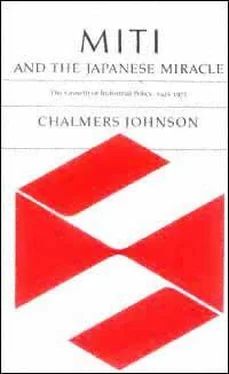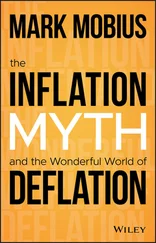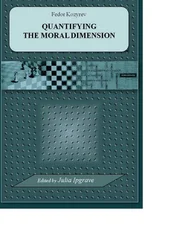Chalmers Johnson - MITI and the Japanese miracle
Здесь есть возможность читать онлайн «Chalmers Johnson - MITI and the Japanese miracle» весь текст электронной книги совершенно бесплатно (целиком полную версию без сокращений). В некоторых случаях можно слушать аудио, скачать через торрент в формате fb2 и присутствует краткое содержание. Год выпуска: 2007, Издательство: Stanford University Press, Жанр: Старинная литература, на английском языке. Описание произведения, (предисловие) а так же отзывы посетителей доступны на портале библиотеки ЛибКат.
- Название:MITI and the Japanese miracle
- Автор:
- Издательство:Stanford University Press
- Жанр:
- Год:2007
- ISBN:нет данных
- Рейтинг книги:3 / 5. Голосов: 1
-
Избранное:Добавить в избранное
- Отзывы:
-
Ваша оценка:
- 60
- 1
- 2
- 3
- 4
- 5
MITI and the Japanese miracle: краткое содержание, описание и аннотация
Предлагаем к чтению аннотацию, описание, краткое содержание или предисловие (зависит от того, что написал сам автор книги «MITI and the Japanese miracle»). Если вы не нашли необходимую информацию о книге — напишите в комментариях, мы постараемся отыскать её.
MITI and the Japanese miracle — читать онлайн бесплатно полную книгу (весь текст) целиком
Ниже представлен текст книги, разбитый по страницам. Система сохранения места последней прочитанной страницы, позволяет с удобством читать онлайн бесплатно книгу «MITI and the Japanese miracle», без необходимости каждый раз заново искать на чём Вы остановились. Поставьте закладку, и сможете в любой момент перейти на страницу, на которой закончили чтение.
Интервал:
Закладка:
Numerous individuals and organizations have helped me with this study. In Japan my primary debts are to Professors Masumi Junnosuke and Akagi Suruki of Tokyo Metropolitan University, who have guided me to materials, discussed the subject with me extensively, and indicated which topics were of greater and lesser significance. Yokokawa Hiroshi of MITI studied at Berkeley during the year 197879 and made many important contributions to my seminar on Japanese politics. In obtaining the sometimes fugitive materials on MITI's past, I have received invaluable assistance from Yutani Eiji of the East
Page x
Asiatic Library, University of California, Berkeley, and Murata Shiro * of the Murata Bookstore, Takaban 398, Meguro-ku, Tokyo. The Center for Japanese studies of the Institute of East Asian Studies, University of California, Berkeley, has supported my research with funds, a travel grant to Japan, and a superb collegial setting in which to try out some of my ideas. Since beginning this study in 1972, I have had the research assistance of several graduate students at Berkeley, including Fujimoto Tetsuya, Yasuda Ryuji*, Kawamoto Chizuko, Gotoda Teruo, Mikumo Akiko, Matsumoto Yoko, and Chang Dal-joong. My thanks also to Pauline D. Fox of Palm Springs, California, for her eight years of clipping the
Los Angeles Times
for me.
My greatest debt is to Sheila K. Johnson for her professional editing of my prose and her typing of the entire manuscript.
Despite all the generous assistance I have received, I remain responsible for all matters of fact or interpretation in this analysis of MITI and the Showa* era in Japan.

C.J.
BERKELEY
DECEMBER 1980
Page xi
Contents
One
The Japanese ''Miracle"
3
Two
The Economic Bureaucracy
35
Three
The Rise of Industrial Policy
83
Four
Economic General Staff
116
Five
From the Ministry of Munitions to MITI
157
Six
The Institutions of High-Speed Growth
198
Seven
Administrative Guidance
242
Eight
Internationalization
275
Nine
A Japanese Model?
305
Appendixes
A. The Political and Administrative Leadership of the Trade and Industry Bureaucracy, 19251975
327
B. Internal Organization of the Ministry, Selected Dates, 19251973
332
C. The Bureaucratic Careers of Vice-Ministers Sahashi and Imai
339
Notes
343
Bibliography
367
Index
383
Page xiii
Tables
1. Indices of Japanese Mining and Manufacturing Production, 19261978
4
2. Changes in the Size of the Japanese Electorate, 18901969
39
3. Numbers and Universities of Passers of the Higher-Level Public Officials Examinations, 1975 and 1976
58
4. Placement of Graduates of the University of Tokyo Law School, 1975 and 1976
61
5. Relative Rates of Promotion by Entering Class, 1975
64
6. MITI Vice-Ministers and Their Amakudari Positions, 1978
72
7. Price Fluctuations, July 1914March 1920
91
8. Indices of the World Economic Crisis, 19301935
121
9. Leaders of the Cabinet Planning Board, 19371943
138
10. The Top Ten Japanese Mining and Manufacturing Corporations, 19291972
158
11. Directors of the Economic Stabilization Board, 19461952
182
12. Government Payments of Price Subsidies and Indemnities, 19401952
184
13. Indices of Economic Activity, 1949 and 1950
187
14. Governors of the Bank of Japan, 19451975
201
15. Sources of Industrial Capital, 19531961
212
16. Japan's Business Cycle, 19501974
219
17. Plans of the Economic Planning Agency, 19551960
231
18. Growth Rates, 19551965
237
Page xv
Abbreviations
AML
Antimonopoly Law
BOT
Board of Trade
Butsudo *
Materials Mobilization Plans
CPB
Cabinet Planning Board
EDA
Economic Deliberation Agency
EPA
Economic Planning Agency
ESB
Economic Stabilization Board
FILP
Fiscal Investment and Loan Plan
FTC
Fair Trade Commission
GATT
General Agreement on Tariffs and Trade
GNP
Gross National Product
IMF
International Monetary Fund
ITB
International Trade Bureau
JDB
Japan Development Bank
JETRO
Japan External Trade Organization
Keidanren
Federation of Economic Organizations
LDP
Liberal Democratic Party
MAC
Ministry of Agriculture and Commerce
MCI
Ministry of Commerce and Industry
MITI
Ministry of International Trade and Industry
MM
Ministry of Munitions
MSEA
Medium and Smaller Enterprises Agency
Page xvi
NREA
Natural Resources and Energy Agency
OECD
Organization for Economic Cooperation and Development
RFB
Reconstruction Finance Bank
SCAP
Supreme Commander for the Allied Powers
SMRR
South Manchurian Railroad
TIRB
Temporary Industrial Rationality Bureau
TMCB
Temporary Materials Coordination Bureau
Page 3
One
The Japanese "Miracle"
By common agreement among the Japanese, the "miracle" first appeared to them during 1962. In its issues of September 1 and 8, 1962, the
Economist
of London published a long two-part essay entitled "Consider Japan," which it later brought out as a book that was promptly translated and published in Tokyo as
Odorokubeki Nihon
(Amazing Japan). Up to this time most Japanese simply did not believe the rate of economic growth they were achievinga rate unprecedented in Japanese historyand their pundits and economists were writing cautionary articles about how the boom would fail, about the crises to come, and about the irrationality of government policy.
1
Yet where the Japanese had been seeing irresponsible budgets, ''over-loans," and tremendous domestic needs, the
Economist
saw expansion of demand, high productivity, comparatively serene labor relations, and a very high rate of savings. Thus began the praise, domestic and foreign, of the postwar Japanese economyand the search for the cause of the "miracle."
First, some details on the miracle itself. Table 1 presents indices of industrial production for the entire period of this study, 1925 to 1975, with 1975 as 100. It reveals several interesting things. The miracle was actually only beginning in 1962, when production was just a third of what it would be by 1975. Fully half of Japan's amazing economic strength was to be manifested after 1966. The table also shows clearly the "recessions" of 1954, 1965, and 1974 that spurred the government to new and even more creative economic initiatives; and it demonstrates the ability of the Japanese economy to come back even more strongly from these periods of adversity. Intersectoral shifts are also recorded: the decline of mining as coal gave way to oil and the move-
Page 4
TABLE 1
Indices of Japanese Mining and Manufacturing Production, 19261978
(1975 = 100)
Manufacturing industries
Year
All industry
Public utilities
Mining and manu- facturing
Mining
All manu- facturing
Iron and steel
Non- ferrous metals
Metal finished goods
Ma- chinery
Ceramics and cement
Chem- icals
Petro- leum
and coal products
Pulp and paper
Textiles
Wood and wood products
Food
1926
2.5
54.5
1.5
4.0
1.5
0.7
4.9
17.4
Читать дальшеИнтервал:
Закладка:
Похожие книги на «MITI and the Japanese miracle»
Представляем Вашему вниманию похожие книги на «MITI and the Japanese miracle» списком для выбора. Мы отобрали схожую по названию и смыслу литературу в надежде предоставить читателям больше вариантов отыскать новые, интересные, ещё непрочитанные произведения.
Обсуждение, отзывы о книге «MITI and the Japanese miracle» и просто собственные мнения читателей. Оставьте ваши комментарии, напишите, что Вы думаете о произведении, его смысле или главных героях. Укажите что конкретно понравилось, а что нет, и почему Вы так считаете.












